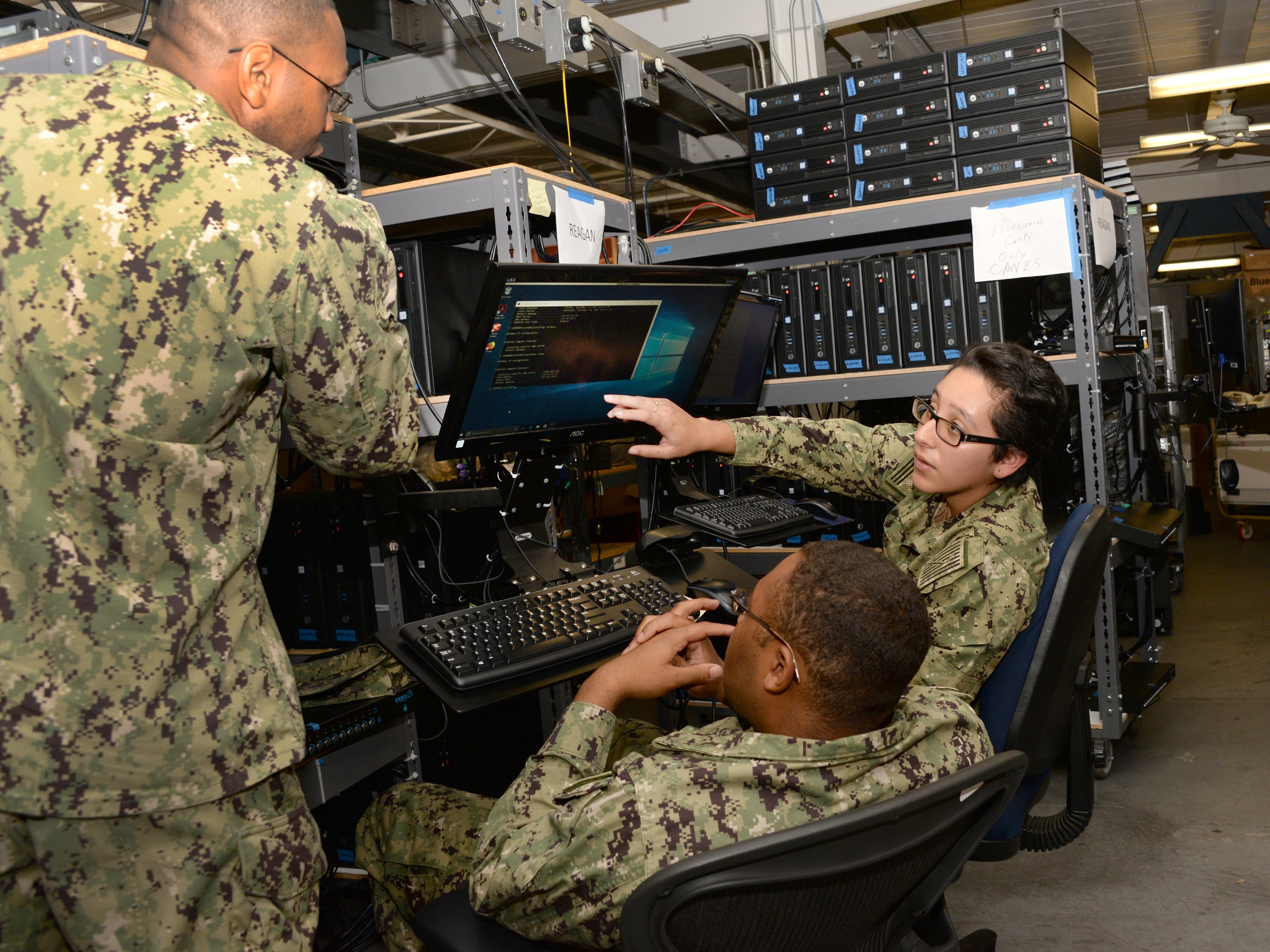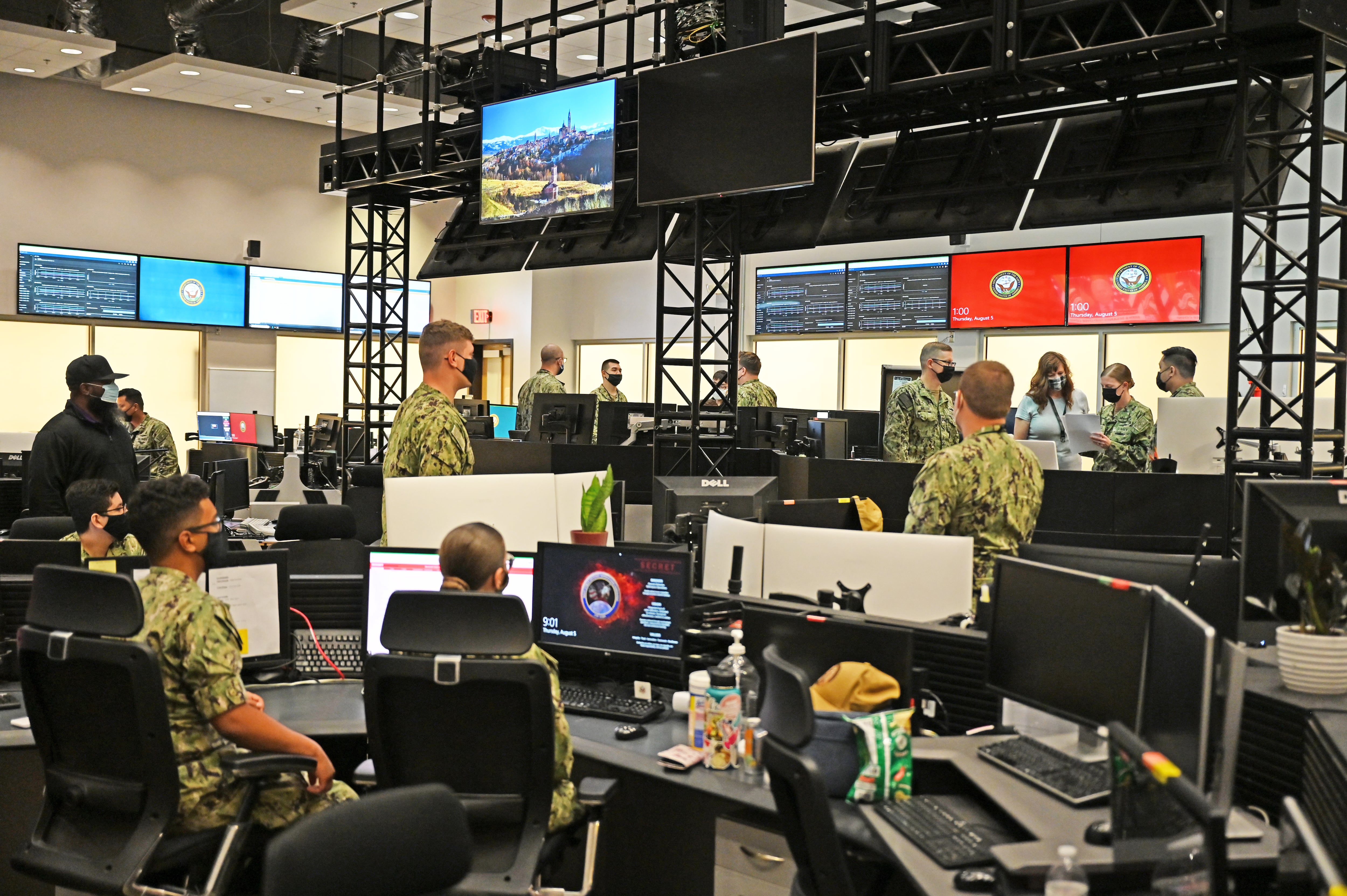NORFOLK, Va. — U.S. Navy and Marine Corps leaders are pushing to make Live, Virtual and Constructive training environments more realistic because, they say, lives are at stake.
The services already have LVC training systems that go beyond basic simulators for a single pilot or infantryman and connect sailors and Marines at different training centers and ships. This allows them to see a complex picture of U.S. and adversary forces, some of which are real and some of which are simulated.
Now they are trying to speed the integration of more systems into the LVC training environment. The Navy and the Marines say they have the basic backbone in place, with some platforms and systems fully integrated into this network. But they need further integration, so the entire naval force and all the tools at its disposal can train in this LVC environment.
RELATED

“We have to be able to link the ships that are training off the East Coast with an exercise that’s going on in the South China Sea with something unmanned that’s happening in 5th Fleet in Bahrain with some Marine unit that’s flying F-35s in Twentynine Palms,” Commandant of the Marine Corps Gen. David Berger said this month at the Navy League’s annual Sea Air Space conference in Maryland.
“We have to tie all that together so that the virtual, live, constructive, all aspects of that are all woven together,” he said. ”That’s how we take [training] to another level — and we’re headed there, but we’ve got to keep the resources behind it or it will fall off, and we can’t let that happen.”
In a separate panel at the conference, Vice Adm. Scott Conn, the deputy chief of naval operations for warfighting requirements and capabilities, explained why it was so important to put aircraft, surface ships, submarines, cyber capabilities and more all into connected LVC training scenarios.
The LVC training environment allows the sailors “to be able to see scenarios you couldn’t show them before, to be able to see things in training before they see it in combat,” he said. “Because when you see something for the first time, you pause, and when you pause in combat, people die.”
Conn told Defense News that modern aircraft and weapons can fly longer than the area of some of the largest training ranges. Also, there are some tactics the Navy may not want to practice in real life due to spying concerns, and there are some weapons that would conflict with or endanger commercial air traffic and communications, making LVC the only way to practice them before combat.
Lagging behind
The aviation community is lagging behind its surface ship counterparts in being able to tap into the LVC netted environment, according to Adm. Daryl Caudle, the head of U.S. Fleet Forces Command.
There is no daylight between Conn at the Pentagon and himself in recognizing the importance of these investments in the LVC training environment, he said, but acquiring the right technology can be very challenging.
“We have done a lot to get ourselves down the road to being able to integrate our training requirements into the ships and aviation and training centers through the LVC suite of technologies, where we can simulate our blue forces, our red forces, practice our concepts of operations [without showing] our adversaries or potential adversaries everything I’m doing,” Caudle told Defense News in a March 30 interview in his Norfolk office. “It also just allows me to actually test things I cannot do with live: I cannot actually shoot adversary weapons at myself and have that show up on the screens that I want the operators to be able to diagnose, find, fix, track and engage to take that out to protect high value units or themselves.”
“We’re very mature shipboard. We’re very mature training center-wise,” he said. “I’m not as far along the lines in the aviation space,” meaning pilots can’t be fully looped into larger fleet training events in the LVC training environment.
“Now, aviation has a lot of ways to do synthetic training,” Conn said. “It’s just not integrated synthetic training.”
For example, whereas the ships in a carrier strike group can all have LVC training scenarios piped into their combat systems — allowing the ship to see both real and simulated aircraft and missiles in their airspace and rehearse defensive tactics while at sea — the aircraft in the carrier air wing can’t see the same simulated threats inside their cockpits.
“If you go out to [Naval Air Station Fallon, Nevada], they’re doing things like this all the time. If you go down to [Naval Air Station Jacksonville, Florida], they’re able to do this, too,” Caudle said. “I’m trying to integrate that more closely, and then really make sure that the high-end weapon systems that are coming online, like F-35, are baked into the actual LVC enterprise.”

The IW community is also struggling to tap into this larger LVC training environment, Vice Adm. Kelly Aeschbach, the commander of Naval Information Forces, said at the WEST naval conference in February in San Diego.
She said there are two key problems for the IW community: it’s been hard for engineers to take their weapons systems and integrate them into the LVC environment, or otherwise replicate the weapons’ effects accurately, she said; and the Navy needs to move its classified training to a Top Secret/Sensitive Compartmented Information level so “we can really maximize the presentation of the threat, and make everything much more realistic for everyone.”
Aeschbach told reporters at the conference that, on the classification issue, the Navy made progress last year in dealing with the “bureaucratic” challenges of getting approvals to operate at the TS/SCI level on LVC systems. In fiscal 2025, she said, the Navy wants to test an LVC training event on a ship at sea at this classification level — which is important because, she said, at the secret level “we don’t really have much representation in terms of information warfare capability.”
On the engineering challenges, Aeschbach told reporters that last year the IW community ran seven or eight pilot programs to bring existing systems including AN/SLQ-32 shipboard electronic warfare suite and the Ships Signal Exploitation Equipment Increments E and F into the LVC training environment.
“There have been challenges working backwards on existing capabilities on how you connect them, or replicate what they do independently so it’s like you’re really using them when you’re in the [LVC] system,” she said. “Some of that is straightforward, and some of that turns out to be challenging for the engineers.”
The IW community determined it needed more time between events to allow for this engineering troubleshooting, “and so we have a less aggressive schedule this coming year, which affords more time for the feedback loop on how they take on some of the engineering stuff, knock it down, and then we move into the next pilot,” Aeschbach said.
C4ISRNET reporter Colin Demarest contributed to this report.
Megan Eckstein is the naval warfare reporter at Defense News. She has covered military news since 2009, with a focus on U.S. Navy and Marine Corps operations, acquisition programs and budgets. She has reported from four geographic fleets and is happiest when she’s filing stories from a ship. Megan is a University of Maryland alumna.





